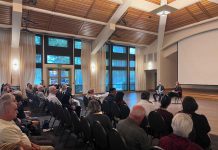Maybe it’s because state legislators have no idea today what
their districts will look like next year and who or what they’ll be
up against.
Maybe it’s because state legislators have no idea today what their districts will look like next year and who or what they’ll be up against.
Maybe it’s because the moment anyone in public life even begins to talk about changing the slightest aspect of Proposition 13, the landmark 1978 property tax-cutting initiative, that person comes under immediate and intense attack from the Howard Jarvis Taxpayers Assn., which uses its vast array of mailing lists to arouse instant resentment against any and all supposed transgressors.
So great is the intimidation factor that Proposition 13 has remained untouched for almost 33 years – and so have the far more dicey regulations adopted to implement it the year after it passed.
During that time, three new public university campuses have opened in California, six governors have come and gone and one has come back again, Proposition 13 author Howard Jarvis and his tax-protesting sidekick Paul Gann have died, freeways and ballparks have been built from scratch, California has endured two major earthquakes and a couple more that bordered on that status and the San Francisco Giants, Los Angeles Dodgers and Los Angeles Angels of Anaheim have all won World Series championships.
Eras have come and gone in politics, sports, entertainment and even road building. For sure, it’s a different era, too, in state budgeting and finance.
But there sits Proposition 13, with its mandate that no property can be taxed at more than 1 percent of its most recent sales price or 1 percent of its 1975 assessed value (plus an annual increase of no more than 2 percent in the tax as a slight bow to inflation).
Virtually no one of political significance or influence argues for a change in that basic formula for residential housing. After all, the main reason Proposition 13 passed so handily (65-35 percent) was that home values were rising rapidly in the ’70s, when taxes were directly proportionate to market values. The result was that low-income homeowners and those on fixed incomes were threatened with being taxed out of their homes.
But the campaign for Proposition 13 barely mentioned commercial property, which today is a prime beneficiary of the measure. For commercial and industrial properties are taxed using the same formula as homes. And while residential property changes hands an average of once every seven years in California, commercial property is far less volatile.
What’s more, Proposition 13 assessment rules passed in 1979 let many properties evade the tax increases to which virtually all homes are subject. If a merger occurs, property taxes can often remain stable (one recent case: The takeover of Sav-On Drugs by CVS Caremark took the form of a merger, and thus has seen few increases in property taxes paid on stores it owns).
Additionally, when apartment buildings or other properties are bought by limited partnerships, there is often no increase in property taxes unless a single individual holds a controlling stake in the new ownership.
When changes to these rules – not part of Proposition 13, but adopted the year after it passed – were first proposed in the Legislature early in the last decade by former Democratic state Sen. Martha Escutia, they were essentially hooted off the floor by fellow lawmakers fearful of political electrocution if they touched any aspect of Proposition 13.
At the time, changing just those rules could have raised $5 billion a year without impacting a single homeowner or existing business. That was then enough to resolve the state’s budget problem.
But with the state’s financial crunch much worse today and showing few signs of ebbing, and with universities, public schools, parks, Medi-Cal, police, fire prevention and other essential public services being cut not merely to the bone, but into the bone, it’s time some things became fair game at last.
Some of the monies held by special districts (topping $41 billion according to some credible estimates) ought to be part of the solution. The rules of what constitutes a change of property ownership also need another look. And it’s high time to consider seriously a “split roll” of property taxation, where commercial property is perhaps not taxed at its actual market value, but certainly at a higher rate than homes.
If California fails to make moves like these, while continuing to cut services to its students, services and have-nots – people essentially without much of a political voice – we will deserve whatever epidemics, crimes, wildfire damage and other problems we get.
Email Thomas Elias at td*****@*ol.com. His book, “The Burzynski Breakthrough,” is available in a soft cover fourth edition. For more Elias columns, visit www.californiafocus.net.







